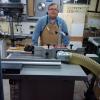Yep, over a year ago I went metric and haven't looked back, at least for my own work. I have some client work that I necessarily need to do in Imperial because of specifications and sometimes provided artwork...this is largely subcontract stuff so I have to work in the same dimensions as the client or it gets to be a difficult conversation. I don't like mixing two measurement systems in the same project. The transition was uncomfortable for a little while, but I persisted and now I'm starting to think in metric without having to pause as much to "mentally convert" approximates for visualization. I know what 200, 400, 600, 800, etc., mm represents "in space" now, more or less. Most of my tooling (router bits for the CNC) is Imperial size, but that really doesn't matter because the software and machine deals with that transparently.
There have been a number of debates around this over time here. IMHO...it doesn't matter what an individual prefers and uses as long as they are consistent and avoid mixing systems as much as reasonably possible. Neither metric or Imperial or whatever are "inferior" to another. They are just units of measure. Use what you like and don't be afraid to try alternative, either if it's appropriate, required for a project or just to test the waters. At a minimum, I believe it's a very good idea for anyone to at least be "conversant" in the alternative measuring system simply because at some point, most, if not all of us, are going to be interacting with someone using the alternative. It's a little harder to do that for many folks growing up in North America (primarily the US) because we never learned metric in school or even if we did, there was nothing that forced us to use it. It's the standard in many industries while often "hidden" from the general public, too. Many folks in other geographies have been exposed to both metric and Imperial to a greater degree.
--
The most expensive tool is the one you buy "cheaply" and often...






 Reply With Quote
Reply With Quote







